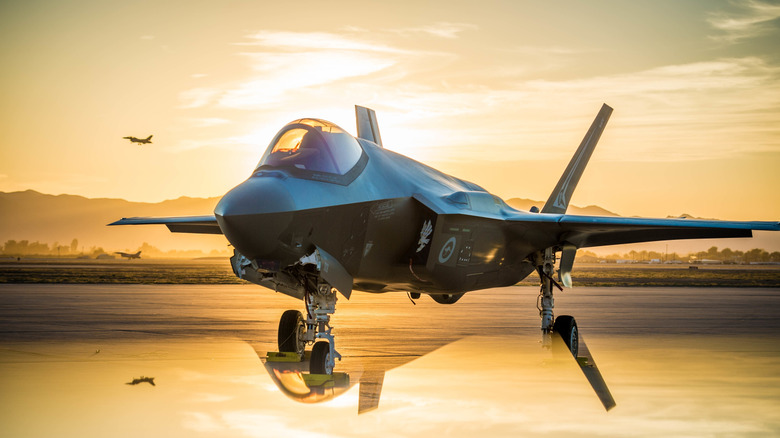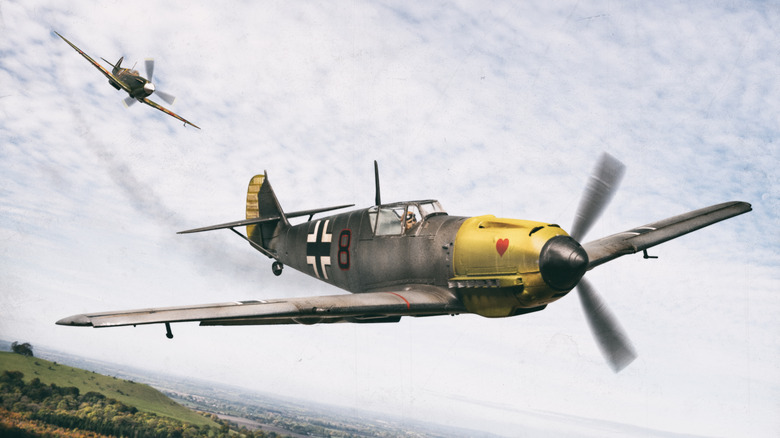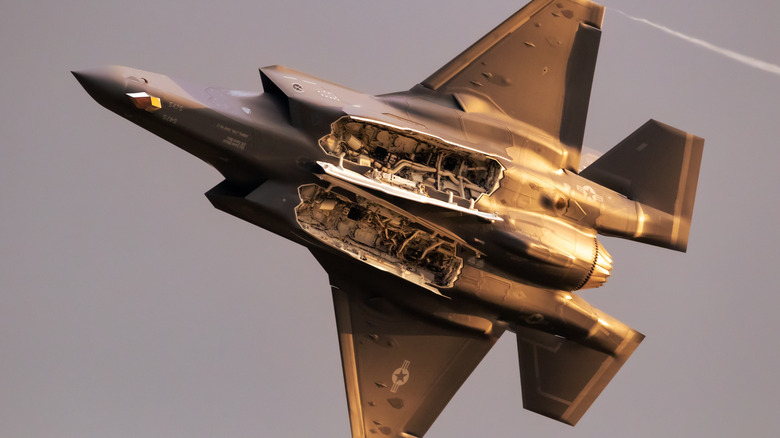How The F-35 Stealth Jet Is Redefining Dogfighting For The Modern Age
By now, you've probably heard all the impressive stories surrounding the F-35 Lightning II. The aircraft has all the makings of a legendary fighter jet, from being among the handful of fighter jets that can hover to sporting one of the most unique fighter jet pilot helmets ever made. The aircraft is more than an advanced weapon system. It is also a capable stealth aircraft that can fly undetected through contested airspace. However, one of its most interesting attributes to date is how it has redefined dogfighting for the modern age by completely eliminating the need for it.
It all comes down to the design of the aircraft. From its stealth features and the long-range armaments concealed within its frame to its advanced situational awareness, everything about the F-35 is aimed at enabling it to eliminate an enemy without engaging in a dogfight. In fact, an F-35 can take out an enemy aircraft that isn't even in visual range. Today, we are discussing dogfights, the F-35's capabilities in those scenarios, and how it has ultimately ushered in a new era of aircraft combat.
Dogfights are rapidly becoming a thing of the past
To understand how the F-35 is establishing a new era for aircraft engagements, we must first review how dogfighting works. Essentially, dogfighting involves pilots attempting to outmaneuver one another to close in for the perfect shot. Maneuvers like tight turns and barrel rolls are commonly seen in these engagements, with most decisive blows coming from the rear. In 2015, an F-35 and two F-16s engaged in an air combat maneuvering test flight over the Pacific Ocean near Edwards Air Force Base, where the F-35 failed to hold its own against the F-16s.
The F-35's pilot stated that the plane couldn't turn fast enough or climb as needed, which would disadvantage it during actual dogfights, as it wouldn't be able to dodge well enough or hit the enemy with its weapons. It didn't help that the F-16s were heavier during the test flight because they carried drop tanks while the F-35 didn't even have weapons, which would have added some weight.
Of course, the statement stirred public opinion about whether the F-35 program, a program that involved companies from 19 countries, was worth all the billions the government had invested. The F-35 used in the test was still in its early years, missing components and software that would have enabled it to perform as the pilot desired. It's also noteworthy that all these components and software are available now in today's F-35s.
Ushering in a new age of aerial combat
However, even with this in mind, fifth-generation fighter jet technology has advanced to a level where the need for close-quarter air-to-air combat has taken a backseat. It has been eight decades since World War II, when dogfights dominated many theaters of war. While U.S. Air Force pilots train on the intricacies of aerial combat maneuvering, even going over how dogfighting operated during that and other eras, it is evident that such engagements are not as common today. This can be seen in the technology available, such as the F-35 and the various systems that contribute to its capabilities.
Several aspects make the F-35 stand out in an era where fighter jets can engage one another without being in close proximity. The first is its Beyond Visual Range (BVR) weapons, like the Meteor air-to-air missile, which can be launched from extremely long distances. The second aspect is its stealth technology, which includes its radar-absorbing gray coating, internal weapons, and shape that minimizes radar reflections.
There's also the aircraft's sensors, which can feed real-time battlefield data straight to the pilot's helmet for situational awareness. That data can also be shared with other crafts and bases for assistance.


